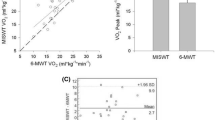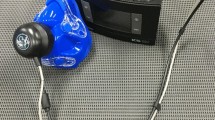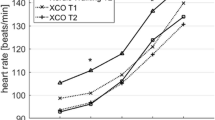Abstract
Cardio-respiratory responses of young and older subjects performing walking and running protocols at the walk–run transition speed (WRT) were compared. A total of 26 volunteers assigned to younger (YG, 24 ± 3 years) and older (OG, 64 ± 6 years) groups underwent a protocol to determine the WRT used in 6-min walking and running protocols. Oxygen uptake (VO2), ventilation (V E), expired carbon dioxide (VCO2), heart rate (HR) and perceived exertion (RPE) were assessed. Oxygen pulse (O2 pulse) and respiratory exchange ratio (RER) were calculated. The WRT was not different between groups (OG: 6.84 ± 0.69 km h−1 vs. YG: 7.04 ± 0.77 km h−1, P = 0.62). No between-group differences were found within a given gait pattern for VO2 (P = 0.061) and VCO2 (P = 0.076). However, VO2 (P = 0.0022) and VCO2 (P = 0.0041) increased in OG when running, remaining stable in YG (VO2: P = 0.622; VCO2: P = 0.412). The VE was higher in OG compared to YG in walking (P = 0.030) and running (P = 0.004) protocols. No age-related (P = 0.180) or locomotion (P = 0.407) effects were found for RER. The HR increased in OG and between-group difference was detected while running (P = 0.003). No within- (P = 0.447) or between-group (P = 0.851) difference was found for O2 pulse. The net VO2 increased from walking to running in OG (P < 0.0001) but not in YG (P = 0.53), while RPE was lower in YG (P = 0.041) but stable in OG (P = 0.654). In conclusion, the WRT speed was similar across the age groups. However, the VO2 and VCO2 increase from walking to running was larger for OG than YG. The HR, VE and RPE were also higher when running in OG compared to YG. Therefore, the locomotion strategy had different impacts on the metabolic demand of older and younger subjects.




Similar content being viewed by others
References
Abernethy B, Burges-Limerik RJ, Engstron C, Hanna A (1995) Temporal coordination of human gait. In: Glencross DJ, Piek JP (eds) Motor control and sensory–motor integration: issues and direction. North-Holland Elsevier, Amsterdam, pp 171–198
American College of Sports Medicine (2006) ACSM’s guidelines for exercise testing and prescription, 7th edn. Lippincott Williams & Wilkins, Baltimore
Bartlett JL, Kran R (2008) Changing the demand on specific muscle groups affects the walk–run transition speed. J Exp Biol 8:1281–1288
Borg G (1998) Borg’s perceived exertion and pain scales. Human Kinetics, Champaign
Brisswalter J, Mottet DJ (1996) Energy cost and stride duration variability at preferred transition gait speed between walking and running. Can J Appl Physiol 21:471–480
Davies MJ, Dalsky GP (1997) Economy of mobility in older adults. J Orthop Sports Phys Ther 26:69–72
Diedrich FJ, Warren JR (1995) Why change gaits? Dynamics of the walk run transition. J Exp Biol 21:183–202
Farinatti PTV, Soares PPS (2009) Cardiac output and oxygen uptake relationship during physical effort in men and women over 60 years old. Eur J Appl Physiol. doi:10.1007/s00421-009-1162-y
Grabowski A, Farley CT, Kram R (2005) Independent metabolic costs of supporting body weight and accelerating body mass during walking. J Appl Physiol 98:579–583
Hanna A, Albernety B, Burgess-Limerick B (2000) Triggers of the transition between human walking and running. In: Sparrow WA (ed) Energetics of human cctivity. Human Kinetics, Champaign, pp 124–164
Hausdorff JM (2007) Gait dynamics, fractals and falls: finding meaning in the stride-to-stride fluctuations of human walking. Hum Mov Sci 26:555–589
Hausdorff JM, Nelson ME, Kaliton D, Layne JE, Bernstein MJ, Nuernberger A, Fiatarone Singh MA (2002) Etiology and modification of gait instability in older adults: a randomized controlled trial of exercise. J Appl Physiol 90:2117–2129
Holverda S, Bogaard HJ, Groepenhoff H, Postmus PE, Boonstra A, Vonk-Noordegraaf A (2008) Cardiopulmonary exercise test characteristics in patients with chronic obstructive pulmonary disease and associated pulmonary hypertension. Respiration 76:160–167
Hreljac A (1995) Determinants of the gait transition speed during human locomotion: kinetic factors. J Biomech 28:669–677
Kostka T, Drygas W, Jegier A, Zaniewicz D (2009) Aerobic and anaerobic power in relation to age and physical activity in 354 men aged 20–88 years. Int J Sports Med 30:225–230
Kozakai R, Tsuzuku S, Yabe K, Ando F, Niino N, Shimokata H (2000) Age-related changes in gait velocity and leg extension power in middle-aged and elderly people. J Epidemiol 10:S77–S81
Lafortuna CL, Agosti F, Galli R, Busti C, Lazzer S, Sartorio A (2008) The energetic and cardiovascular response to treadmill walking and cycle ergometer exercise in obese women. Eur J Appl Physiol 103:707–717
Menz HB, Lord SR, Fitzpatrick RC (2003) Age-related differences in walking stability. Age Ageing 32:137–142
Mercier J, Legallais D, Durand M, Goudal C, Micallef JP, Prefaut C (1994) Energy expenditure and cardiorespiratory responses at the transition between walking and running. Eur J Appl Physiol 69:525–529
Neder JA, Nery JE, Peres C, Whipp BJ (2001) Reference values for dynamic responses to incremental cycle ergometry in males and females aged 20 to 80. Am J Respir Crit Care Med 164:1481–1486
Neptune RR, Sasaki K (2005) Ankle plantar flexor force production is an important determinant of the preferred walk-to-run transition speed. J Exp Biol 208:799–808
Patterson RP, Remole WD (1981) The response of the oxygen pulse during a stress test in patients with coronary artery disease. Cardiology 67:52–62
Prilutsky BI, Gregor RJ (2001) Swing and support-related muscle actions differentially trigger human walk–run and run–walk transitions. J Exp Biol 204:2277–2287
Rotstein A, Inbar O, Berginsky T, Meckel Y (2005) Preferred transition speed between walking and running: effects of training status. Med Sci Sports Exerc 37:1864–1870
Saibene F, Minetti AE (2003) Biomechanical and physiological aspects of legged locomotion in humans. Eur J Appl Physiol 88:297–316
Sasaki K, Neptune RR (2006) Muscle mechanical work and elastic energy utilization during walking and running near the preferred gait transition speed. Gait Posture 23:383–390
Scharhag-Rosenberger F, Meyer T, Gäßler N, Faude O, Kindermann W (2009) Exercise at given percentages of VO2max: heterogeneous metabolic responses between individuals. J Sci Med Sport. doi:10.1016/j.jsams.2008.12.626
Schibye B, Hansen AF, Søgaard K, Christensen H (2001) Aerobic power and muscle strength among young and elderly workers with and without physically demanding work tasks. Appl Ergon 32:425–431
Segers V, Lenoir M, Aerts P, De Clerq D (2007) Influence of m. tibialis anterior fatigue on the walk-to-run and run-to-walk transition in non-steady state locomotion. Gait Posture 25:639–647
Shung K, Oliveira CG, Nadal J (2009) Influence of shock waves and muscle activity at initial contact on walk–run transition evaluated by two models. J Appl Biomech 25:175–183
Sparrow WA, Hughes KM, Russel AP, Le Rossignol PF (2000) Movement economy, preferred modes, and pacing. In: Sparrow WA (ed) Energetics of human activity. Human Kinetics, Champaign, pp 96–123
Takeshima N, Kobayashi F, Watanabe T, Tanaka K, Tomita M, Pollock ML (1996) Cardiorespiratory responses to cycling exercises in trained and untrained healthy elderly: with special reference to the lactate threshold. Appl Human Sci 15:267–273
Tanaka H, Desouza CA, Jones PP, Stevenson ET, Davy KP, Seals DR (1997) Greater rate of decline in maximal aerobic capacity with age in physically active vs. sedentary healthy women. J Appl Physiol 83:1947–1953
Thorstensson A, Roberthson H (1987) Adaptations to changing speed in human locomotion: speed of transition between walking and running. Acta Physiol Scand 131:211–214
Tseh W, Bennett J, Caputo JI (2002) Comparison between preferred and energetically optimal transition speeds in adolescents. Eur J Appl Physiol 88:117–121
Unberger BR, Martin PE (2007) Mechanical power and efficiency of level walking with different stride rates. J Exp Biol 210:3255–3265
Wajngarten M, Negrão CE, Kalil LMP, Ramires PR, Rondon E, Haebisch H, Bellotti G, Serro-Azul LG, Decourt LV, Pileggi F (1994) Influence of aging and exercise training on the increase in oxygen uptake as a function of the increase in work rate. Cardiol Elder 2:421–426
Wall JC, Charteris J (1980) The process of habituation to treadmill walking at different velocities. Ergonomics 23:425–435
Wall JC, Charteris J (1981) A kinematic study of long-term habituation to treadmill walking. Ergonomics 24:531–542
Whipp BJ, Wasserman K (1972) Oxygen uptake kinetics for various intensities of constant-load work. J Appl Physiol 33:351–356
Acknowledgments
This study was partially supported by the Carlos Chagas Filho Foundation for the Research Support in the State of Rio de Janeiro (FAPERJ, process E-26/150.751/2007) and by the Brazilian Council for the Scientific and Technological Development (CNPq, process 305729/2006-3 and process 307671/2009-7).
Author information
Authors and Affiliations
Corresponding author
Additional information
Communicated by Susan Ward.
Rights and permissions
About this article
Cite this article
Farinatti, P.T.V., Monteiro, W.D. Walk–run transition in young and older adults: with special reference to the cardio-respiratory responses. Eur J Appl Physiol 109, 379–388 (2010). https://doi.org/10.1007/s00421-010-1366-1
Accepted:
Published:
Issue Date:
DOI: https://doi.org/10.1007/s00421-010-1366-1




